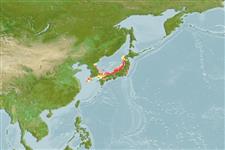Common names from other countries
>
Perciformes/Cottoidei (Sculpins) >
Cottidae (Sculpins)
Etymology: Cottiusculus: Greek, kottos = a fish, diminutive; nihonkaiensis: Named for Nihonkai, the Japanese name of the Sea of Japan, which includes most of the distributional range of the species..
Environment: milieu / climate zone / depth range / distribution range
Écologie
marin démersal; profondeur 100 - 150 m (Ref. 83439). Temperate
Northwestern Pacific: from the Sea of Japan coasts of Hokkaido, Honshu, Kyushu and the Korean Peninsula, and Volcano Bay, Hokkaido.
Taille / Poids / Âge
Maturity: Lm ? range ? - ? cm
Max length : 7.8 cm SL mâle / non sexé; (Ref. 83439); 6.1 cm SL (female)
Description synthétique
Clés d'identification | Morphologie | Morphométrie
Épines dorsales (Total) : 6 - 8; Rayons mous dorsaux (Total) : 11 - 13; Épines anales: 0; Rayons mous anaux: 10 - 13. This species is distinguished by the following set of characters: simple or weakly bicuspid nasal spines; uppermost preopercular spine not barbed; first dorsal fin not elongated; lateral line extending past base of caudal fin, with 2 or 3 lateral line pores on caudal fin; with ventral lateral and lateral line cirri (Ref. 83439).
Usually occurs on sandy-muddy bottoms (Ref. 83439).
Life cycle and mating behavior
Maturities | Reproduction | Spawnings | Egg(s) | Fecundities | Larves
Kai, Y. and T. Nakabo, 2009. Taxonomic review of the genus Cottiusculus (Cottoidei: Cottidae) with description of a new species from the sea of Japan. Ichthyol. Res. 56(3):213-226. (Ref. 83439)
Statut dans la liste rouge de l'IUCN (Ref. 130435)
CITES (Ref. 128078)
Not Evaluated
Menace pour l'homme
Harmless
Utilisations par l'homme
Outils
Articles particuliers
Télécharger en XML
Sources Internet
Estimates based on models
Phylogenetic diversity index (Ref.
82804): PD
50 = 0.6250 [Uniqueness, from 0.5 = low to 2.0 = high].
Bayesian length-weight: a=0.01000 (0.00244 - 0.04107), b=3.04 (2.81 - 3.27), in cm Total Length, based on all LWR estimates for this body shape (Ref.
93245).
Niveau trophique (Ref.
69278): 3.3 ±0.5 se; based on size and trophs of closest relatives
Résilience (Ref.
120179): Milieu, temps minimum de doublement de population : 1,4 à 4,4 années (Preliminary K or Fecundity.).
Fishing Vulnerability (Ref.
59153): Low vulnerability (10 of 100).
